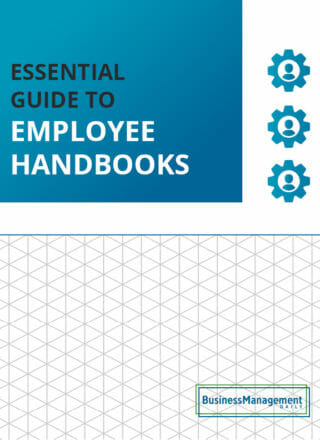How to survive in HR at a company that doesn’t stick to policies

Navigating leadership non-compliance with company policies
Having an up-to-date employee handbook with comprehensive company policies is one of the most crucial steps that small businesses can take to mitigate risk.
A comprehensive employee handbook, filled with well-thought-out policies related to sexual harassment, workplace safety, time and attendance, and employee conduct, will help keep your business running smoothly and in compliance.
Human resources professionals understand the importance of creating and implementing clear workplace policies, but what do HR teams do when other company leaders don’t abide by such policies?
It’s, unfortunately, a common problem. Even worse, sometimes, leaders directly interfere with HR staff members’ ability to enforce company rules. This puts the HR team in an awkward position and opens the company up to liability.
Suppose you’re a human resources professional struggling to get support in enforcing your company’s code of conduct and employee policies. In that case, there are several steps that you can take to help sway internal leaders on the matter.
Explore the potential risks associated with non-compliance with your own company’s policies and learn how to handle working for a company that doesn’t adhere to its policies.
Potential risks associated with not sticking to company policies
Letting things slide here and there may not seem like a significant issue, but failing to adhere to company policies can expose your business to numerous liabilities and unfavorable outcomes. Here are some of the biggest concerns to consider.
Legal complaints and fines
The inconsistent application of company policies can expose your company to claims of discrimination. For example, let’s say you don’t consistently enforce your attendance policy and regularly allow employees to come in late without consequences.
One day, an employee is 15 minutes late, and it causes a minor inconvenience to a customer or another department. As a result, you decide to take disciplinary action against the employee.
That employee will feel singled out and as though they have been mistreated because other employees frequently come in late without facing consequences.
Suppose they fall into one of the groups recognized under Title VII of the Civil Rights Act and believe that this may have influenced the company’s decision to treat them differently regarding disciplinary action.
In that case, the employee in the above scenario is well within their rights to report the behavior to the Equal Employment Opportunity Commission (EEOC) and open a lawsuit. This can result in hefty legal fees and fines for your business.
Workplace accidents and injuries
Most workplaces also have a variety of safety rules in place that are designed to prevent team members from getting hurt on the job. Enforcing these rules and maintaining a safe work environment is incredibly important.
However, many employees circumvent these rules to take shortcuts that enable them to complete tasks more quickly. Line managers may look the other way or choose not to enforce the safety policies in favor of higher productivity.
Policies normally fall out of favor. Times change. Employers and employees change, too. Therefore, the policies are not being enforced. Perhaps the policy no longer aligns with the organization’s desired company culture.
For example, many companies have dress codes. Consistent enforcement no longer occurs. These codes reflect old and outdated attitudes about gender roles and work attire.
Reputation damages
In the age of social media, it’s not hard to destroy your reputation. Employees have numerous outlets to share their grievances with current or past employers, from more traditional avenues like Glassdoor to newer formats like TikTok storytime.
You do not want to be the employer that didn’t give employees their allotted breaks, allowed workplace harassment to go unchecked, or fired an employee over a policy that was rarely enforced. Future prospective employees and customers will research your business and see these unfavorable posts.
News outlets will also occasionally pick up on lawsuits or EEOC complaints, and in these cases, not all press is good press. Additionally, mishandling sensitive information can occur. This is due to a failure. You fail to enforce established policies. Or, you fail to enforce procedures. This can lead to custom notifications.
Furthermore, this can result in a significant loss of trust. Your organization suffers the loss. Ultimately, company policies are in place for a reason, and that reason is typically to protect the company, its reputation, and its employees and customers.
Employee confusion
While not as ominous as lawsuits or government investigations, it’s also worth noting that inconsistency in applying company policies creates a lot of confusion for employees and further issues for HR and people managers. If you fail to stick to policy too many times, that policy effectively doesn’t exist.
Employees may struggle to understand when and how the policy applies within your organization, leading to more team members disregarding it. This sets the company up for failure because when a situation arises where the policy needs to be enforced, it will seem completely unfair to your staff.
New employees who join a company and observe specific policies not being enforced will likely be perplexed and may disregard the policy as an outdated rule that the company has forgotten to remove from its handbook. This is precisely the opposite of what companies should strive to achieve by creating clear policies and a handbook.
How to get support from leadership on enforcing policies
Communicate the risks
Begin by expressing your concern to leadership about the risks associated with inconsistent enforcement of company policies. You have a legal department. Or, you have corporate counsel. Seek their advice. Collaborate with them. Communicate effectively with leadership.
Human resources professionals typically have a strong understanding of employment law. However, leaders are more likely to take concerns seriously. The concerns come from an attorney.
Obtain internal support
Is a certain department manager growing frustrated with their inability to enforce policies within their team? Does a Sales Manager want the dress code enforced so that the office appears more professional when clients visit? Encourage them to speak up as well.
There is strength in numbers. Each department will also be impacted differently when policies aren’t enforced, so they can also provide valuable insight to help you make your case.
Offer to work with leaders to rewrite or update policies
As we’ve discussed above, retaining outdated policies and failing to enforce them consistently can be a liability. If leaders don’t want to enforce the existing written policies, you may want to suggest updating them to create new policies that can be enforced more consistently.
Policies normally fall out of favor. Employers and employees change. Times change. Therefore, the reason policies are not being enforced is simple. The policy no longer aligns with the organization’s desired company culture.
For example, many companies have dress codes that are no longer consistently enforced because they reflect old or outdated attitudes about gender roles and work attire.
First, ask leaders for input. Then, have them revise the policies. Ensure the revisions align with the company’s current culture. Additionally, ensure they align with the desired management style.
Moreover, approach this in a collaborative manner. Do not be confrontational. This is a good approach. You are an HR Manager. You work with leaders. They do not respond positively to pushback.
Perhaps they have not responded to prior attempts. You raised concern. If you need some policy templates to use as a guide, check out our Book of Company Policies.
Compile data
Many business leaders like to make decisions based on hard data. If you’re trying to sway their opinion on an issue, delve into your HR analytics to identify ways to demonstrate the cost of not enforcing policies. The exact metrics will vary based on the policy that isn’t being enforced.
If it’s the attendance policy, tally up the lost minutes and productivity associated with tardiness over a set period (such as a week, month, or quarter). If it’s a safety policy, look to see if there has been a rise in workplace accidents and injuries.
In some instances, if you don’t have any data to back up your concerns, you can create some. That doesn’t mean that you should make up figures. but you can collect data to support your concerns.
One opportunity to do this is when you send out your employee engagement surveys. Employees won’t necessarily care if management is relaxed about company rules, but they will notice if policies are being applied unevenly.
In this circumstance, add a Likert scale statement. For example, use “I feel that company policies are fairly and equitably enforced.” Ask them to agree or disagree. This can help you capture data. The data shows how inconsistencies may impact employee morale.
Furthermore, this can show leaders that their behavior is potentially creating the perception of favoritism. Or it is creating the perception of discrimination.
Get things in writing
 Sometimes, leaders are stubborn, and you won’t be able to get them to change their ways, but you can protect yourself.
Sometimes, leaders are stubborn, and you won’t be able to get them to change their ways, but you can protect yourself.
If you bring an issue to the attention of senior leaders and they do not allow you to enforce company policy, you will want to have that in writing.
This ensures that you aren’t blamed if their non-compliance with their own policies leads to major consequences for the business.
Raise concerns via email. This is helpful. Do not raise concerns verbally. Email creates a paper trail. The issue is discussed verbally. This occurs in a meeting. The meeting is not being recorded.
Therefore, consider sending a follow-up email. Summarize the key points in the email. Also, confirm they do not want you to enforce the policy. This is in this specific instance.
A simple template to follow is: “Hello [Name], I just wanted to follow up on our conversation and confirm that you do not want to take action to enforce [policy] as it relates to [employee name or issue]?
The HR department aims to enforce all company policies consistently but understands that you had concerns regarding [the reason they gave for not implementing the policy]. In the future, how would you like issues related to [policy or behavior] to be handled?
First, ensure you retain relevant emails. Next, keep notes. Also, Slack messages are retained. Additionally, retain meeting recordings. This is in case an issue arises. A complaint may arise. A lawsuit may arise.
Furthermore, you can use these as evidence. You can appeal to a manager. The manager is shutting you down. This is regarding the enforcement of policies.
Ultimately, the human resources department is responsible for protecting both the company and its employees. If the company will not let you defend them, at least protect yourself.






